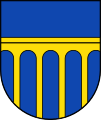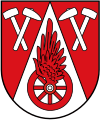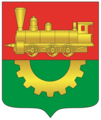Railroad in heraldry

Railway symbols are used relatively rarely in heraldry . In classical heraldry, they are considered unheraldic because they represent a heraldic anachronism . Nevertheless, they are sometimes depicted as a mean figure in modern heraldry (coats of arms of contemporary organizations and people, such as municipal coats of arms ) .
To heraldry
If a railway symbolism is used in a coat of arms, it is usually very strongly stylized, so that the form shown in the coat of arms would not really be suitable for use. Rails and impellers are used more often in the coats of arms than, for example, locomotives or wagons , because the forerunners of a rail system and wheels were also known before the Gothic. Typical is the hunt , which primarily symbolizes mining , not the railroad itself. If rolling goods appear as such, this usually means a significant plant on site, i.e. production, not traffic in particular. But simpler symbols are also used, such as components such as the buffer (in the sense of a shunting station ), barriers or the profile of a rail , for example in Vila Nova da Baronia . Railway knots are also symbolized by various cross shapes , in particular the double crossed St. Andrew's cross as a well-known symbol of the railway crossing.
Because there is no heraldic technical language, as for modern naturalistic figures (apart from the impeller, an old symbol of the messenger of the gods Hermes), the blazon (description of the coat of arms) is also done in natural language, that is, a "rail" or a "locomotive" called. In the absence of a canon of representation, the exact form is then left to the heraldist who designed it, so all details with meaning must be named. Only tinging (color design), arrangement and position are heraldically noted as with every figure, for example a golden locomotive (yellow), an oblique left rail (from heraldic bottom right to top left, from the viewer from bottom left: /) or a railroad barrier in natural colors (this is how it generally looks, with a red and white spar and portcullis in brown, black, gray or similar). Constructing a complicated "heraldically correct" description is considered out of date today, a track could be emblazoned as "floating a silver slanting left twin thread , underneath seven brown narrow slanting shingles placed after the figure ", which is still neither really clear nor catchy would.
Examples
Altenbeken Viaduct , (stylized)
Impeller ( Bad Kleinen DE)
Rail cross (in the coat of arms of Bebra DE)
Grünentaler Hochbrücke (in the coat of arms of Beldorf DE)
Tunnel (in the coat of arms of Heigenbrücken DE)
Railway bridge (in the coat of arms of Hochdonn DE)
Hollenbek DE is on the Kaiserbahn
Locomotive wheel (in the coat of arms of Jübek DE)
The St. Andrew's Cross stands for the Lehrte railway junction
Railway line (in the coat of arms of Neubeckum DE)
Impeller ( Osterfeld DE, formerly)
Railway track ( Pasching AT)
Railroad track ( Raasdorf AT)
Two rails in cross section ( Chalindrey FR)
Golden Locomotive and Cogwheel ( Baranavichy BY)
Impeller (for railways and business) ( Ohligs DE)
Rails with diesel locomotive ( Petrovsk-Sabaikalski RU)
Steam locomotive ( Insa RU)
Steam train ( Villa Alemana CL)
Personal coat of arms ( Mathias von Schönerer )
Coat of arms of the railway companies
The early railroad companies, especially in Great Britain, had a great affinity for heraldry. Coats of arms were very popular with them as a sign of identification in the sense of a logo or to decorate the railway wagons. However, the impeller hardly appears here.
Metropolitan Railway , London (UK)
Pullman sign ( Colne Valley Railway , UK)
literature
- George Dow: Railway Heraldry and Other Insignia. David & Charles Publisher, 1973, ISBN 9780715358962 .
Web links
Individual evidence
- ↑ cf. to Bernhard Peter: Plea for better German in Blasonierungen .
- ↑ Ulla Kremsmayer: municipal coat of arms for Raasdorf awarded , NÖN.at , 10 November 2017
























